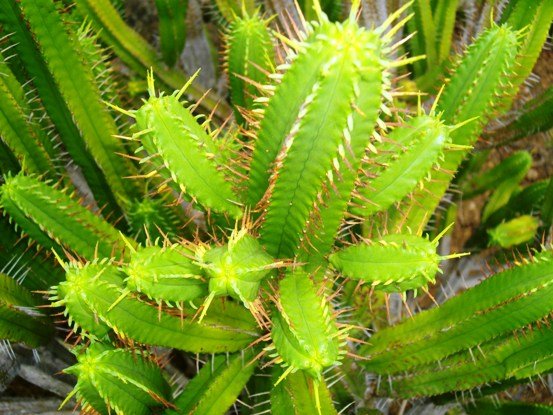Euphorbia pentagona

Author: Ivan Lätti
Photographer: Ivan Lätti
Euphorbia pentagona, commonly known in Afrikaans as noorsdoring (spurge thorn), is a stem succulent. It is a much-branched shrub growing erect, finger-like stems to around 2 m in height and often as wide or wider. Old plants may develop tree-like lower trunks. The latex exuded by any damaged part of this plant may be poisonous.
E. pentagona resembles E. enopla, which is often smaller and more branched, now part of E. heptagona. E. pentagona used to be called E. heptagona in the past. Since that name is still in existence for a recognised species, there is still some confusion relating to species in this related group or complex.
The upper stems of E. pentagona are light green when young, the lower parts pale grey. The stems are five-edged, ribbed or winged, sometimes more of those, occasionally nine-ribbed with yellowish lemon coloured spines along the stem ridges. These spines are really the bare remaining peduncles where cyathia, or after them fruit capsules have dropped off. They first grow darker with age until they later become pale grey. The smooth stem surfaces between the ridges are slightly concave and undulating.
The short-lived leaves on new stem-tip growth are about 4 mm long.
The cyathia of E. pentagona grow solitary or in cymes of up to three at stem-tips on short peduncles that often persist. They are purple or lavender with some buff with attractive spreading bracts and elliptic, dark nectar glands. Cyathium diameter is about 4 mm.
The fruit is a nearly spherical on a short pedicel. It is a dehiscent capsule of about 6 mm in diameter.
The species distribution is in the Eastern Cape from east of Uniondale to near Makhanda (Grahamstown).
The habitat is comparatively dry scrub and thicket. The species is not considered threatened in habitat early in the twenty first century.
The plants are used by traditional populations to make hedges. The dry branches are used as fuel for fires and is common as a garden subject (Frandsen, 2017; iNaturalist; Wikipedia; www.cactus-art.biz; https://www.llifle.com; http://redlist.sanbi.org).

